The Underwater Modems Market is estimated to be valued at USD 783.3 million in 2025 and is projected to reach USD 1644.7 million by 2035, registering a compound annual growth rate (CAGR) of 7.7% over the forecast period.
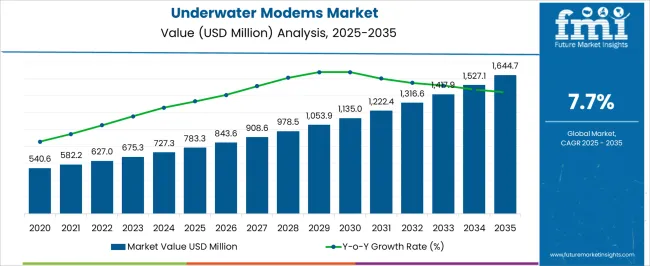
| Metric | Value |
|---|---|
| Underwater Modems Market Estimated Value in (2025 E) | USD 783.3 million |
| Underwater Modems Market Forecast Value in (2035 F) | USD 1644.7 million |
| Forecast CAGR (2025 to 2035) | 7.7% |
The Underwater Modems market is witnessing steady growth, driven by increasing demand for reliable underwater communication systems across sectors such as oil and gas, defense, environmental monitoring, and marine research. The adoption of underwater modems is being fueled by the need for real-time data transmission in challenging subsea environments, where conventional communication technologies are ineffective. Technological advancements, including low-power modulation, robust signal processing, and improved acoustic transceivers, are enhancing the reliability and efficiency of underwater communication systems.
The market is further supported by increasing offshore exploration activities, growing investments in subsea pipeline monitoring, and expanding applications in autonomous underwater vehicles and environmental sensing. Integration with networked monitoring platforms and remote operation systems is improving operational efficiency and decision-making.
Regulatory emphasis on maritime safety and environmental monitoring is further propelling demand As industries increasingly adopt automated and intelligent subsea systems, the Underwater Modems market is expected to experience sustained growth, with innovations in range, material durability, and signal integrity driving future adoption.
The underwater modems market is segmented by application, range, material type, frequency band, end use industry, and geographic regions. By application, underwater modems market is divided into Pipeline Monitoring Systems, Environmental Monitoring System, Oceanographic Instrumentation, Corrosion Monitoring, Seismic Wave Monitoring, Autonomous Underwater Vehicle Communication, Diving, and Aquaculture. In terms of range, underwater modems market is classified into Short Range (1000M), Mid Range (2000M), and Long Range (6000M). Based on material type, underwater modems market is segmented into Aluminum Alloy, Stainless Steel, and Titanium. By frequency band, underwater modems market is segmented into 9-14 KHz, 16-21 KHz, and 25-20 KHz. By end use industry, underwater modems market is segmented into Oil And Gas Industry, Construction Industry, and Defense Industry. Regionally, the underwater modems industry is classified into North America, Latin America, Western Europe, Eastern Europe, Balkan & Baltic Countries, Russia & Belarus, Central Asia, East Asia, South Asia & Pacific, and the Middle East & Africa.
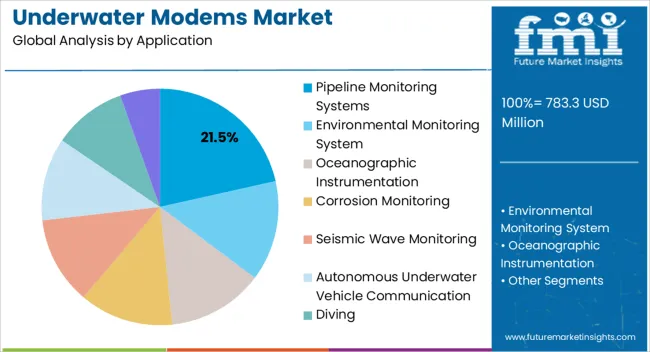
The pipeline monitoring systems application segment is projected to hold 21.5% of the market revenue in 2025, establishing it as the leading application area. Its growth is being driven by the increasing requirement for real-time monitoring of subsea pipelines, ensuring safety, integrity, and leak detection. Underwater modems enable continuous transmission of critical data, allowing operators to respond quickly to potential faults and maintain regulatory compliance.
The ability to integrate modems with automated control systems and remote monitoring platforms reduces operational downtime and enhances efficiency. Technological advancements in acoustic communication, error correction, and energy-efficient designs have further improved reliability, making pipeline monitoring a primary use case.
Investments by energy companies and regulatory mandates for safe and environmentally responsible pipeline operations are reinforcing the segment’s adoption As the offshore oil and gas industry expands, and the demand for automated and connected subsea systems grows, the pipeline monitoring systems segment is expected to maintain its leading position, supported by innovations in data transmission and system integration.
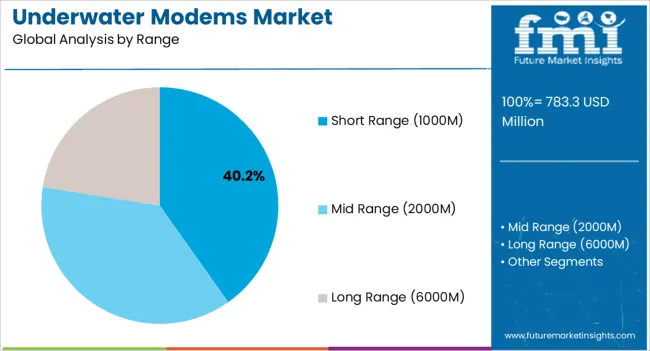
The short range (1000M) segment is expected to account for 40.2% of the market revenue in 2025, making it the leading range category. Its prominence is being driven by applications that require reliable communication over moderate distances, such as subsea monitoring, scientific research, and underwater vehicle coordination. Short-range modems provide low-latency, energy-efficient communication that is suitable for dense network deployments where longer-range systems may face interference or higher power consumption.
Advancements in signal processing, acoustic transducers, and data compression have enhanced the effectiveness of short-range underwater communication. Organizations are increasingly adopting these systems due to their cost-effectiveness, ease of deployment, and integration capability with existing underwater infrastructure.
The segment’s growth is also supported by expanding applications in autonomous underwater vehicles, subsea robotics, and environmental sensing As the need for precise, real-time underwater data continues to rise, the short-range category is expected to maintain its market leadership, supported by innovations that enhance reliability, efficiency, and operational flexibility.
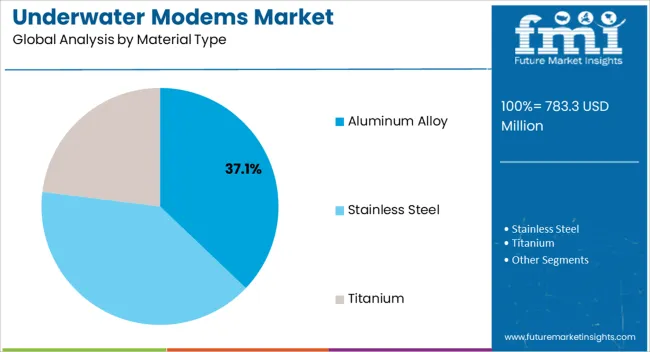
The aluminum alloy material type segment is projected to hold 37.1% of the market revenue in 2025, establishing it as the leading material category. Its adoption is driven by the need for lightweight, corrosion-resistant, and mechanically robust housing for underwater modems. Aluminum alloys provide excellent structural integrity while reducing overall device weight, facilitating easier deployment and handling in subsea environments.
The material’s durability under high-pressure and saline conditions ensures long operational lifespans, reducing maintenance and replacement costs. Compatibility with advanced coating and sealing techniques enhances protection against corrosion, biofouling, and wear. The segment is further supported by applications in pipeline monitoring, underwater exploration, and marine research, where reliable performance is critical.
As industries increasingly prioritize equipment longevity, safety, and operational efficiency, aluminum alloy remains the preferred material choice for underwater modem construction Its combination of strength, durability, and cost-effectiveness continues to reinforce its leading position in the market.
Underwater modems are used to transmit data wirelessly through water. With the introduction of underwater modems, users can now communicate, navigate and monitor under water. The use of technologies like Wi-Fi and GPS, beneath the water surface, has been made possible by the introduction of underwater modems.
These are also known as acoustic modems. Underwater acoustic communication has low data rates due to the acoustic waves used for transmission rather than the electromagnetic waves. Underwater modems are used in a variety of applications for data gathering and monitoring for marine applications.
Different modems are installed based on specific requirements like short-term deployment, long-term deployment and corrosion resistance. The use of underwater modems by the defense industry for communication between submarines is expected to drive the global underwater modem market.
Incre’asing investments made in research and development and data monitoring underwater, surveys and environmental studies has led to further growth in the underwater modems market. Moreover, underwater modems are also used for autonomous under vehicle communication. The market for underwater modems is expected to increase at a moderate CAGR over the forecast period.
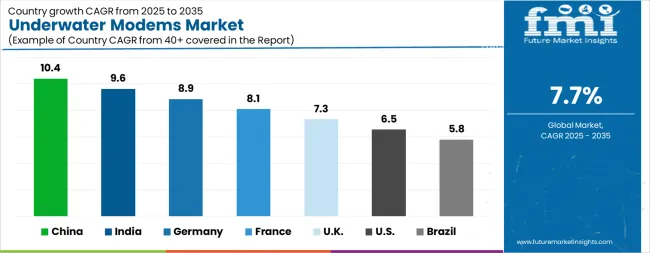
| Country | CAGR |
|---|---|
| China | 10.4% |
| India | 9.6% |
| Germany | 8.9% |
| France | 8.1% |
| UK | 7.3% |
| USA | 6.5% |
| Brazil | 5.8% |
The Underwater Modems Market is expected to register a CAGR of 7.7% during the forecast period, exhibiting varied country level momentum. China leads with the highest CAGR of 10.4%, followed by India at 9.6%. Developed markets such as Germany, France, and the UK continue to expand steadily, while the USA is likely to grow at consistent rates. Brazil posts the lowest CAGR at 5.8%, yet still underscores a broadly positive trajectory for the global Underwater Modems Market. In 2024, Germany held a dominant revenue in the Western Europe market and is expected to grow with a CAGR of 8.9%. The USA Underwater Modems Market is estimated to be valued at USD 296.5 million in 2025 and is anticipated to reach a valuation of USD 558.9 million by 2035. Sales are projected to rise at a CAGR of 6.5% over the forecast period between 2025 and 2035. While Japan and South Korea markets are estimated to be valued at USD 38.7 million and USD 19.7 million respectively in 2025.
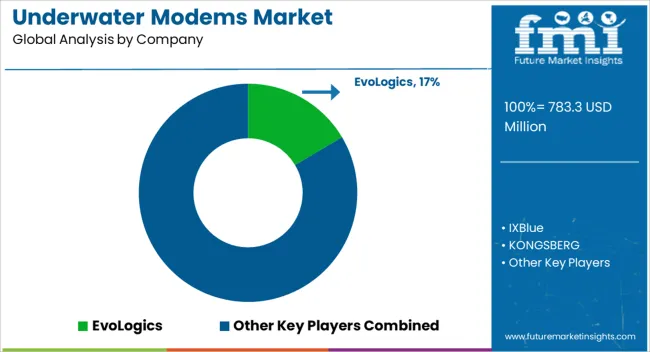
| Item | Value |
|---|---|
| Quantitative Units | USD 783.3 Million |
| Application | Pipeline Monitoring Systems, Environmental Monitoring System, Oceanographic Instrumentation, Corrosion Monitoring, Seismic Wave Monitoring, Autonomous Underwater Vehicle Communication, Diving, and Aquaculture |
| Range | Short Range (1000M), Mid Range (2000M), and Long Range (6000M) |
| Material Type | Aluminum Alloy, Stainless Steel, and Titanium |
| Frequency Band | 9-14 KHz, 16-21 KHz, and 25-20 KHz |
| End Use Industry | Oil And Gas Industry, Construction Industry, and Defense Industry |
| Regions Covered | North America, Europe, Asia-Pacific, Latin America, Middle East & Africa |
| Country Covered | United States, Canada, Germany, France, United Kingdom, China, Japan, India, Brazil, South Africa |
| Key Companies Profiled | EvoLogics, IXBlue, KONGSBERG, L3Harris, LinkQuest, Ocean Infinity, Popoto Modem, Sonardyne, Teledyne, and Water Linked |
The global underwater modems market is estimated to be valued at USD 783.3 million in 2025.
The market size for the underwater modems market is projected to reach USD 1,644.7 million by 2035.
The underwater modems market is expected to grow at a 7.7% CAGR between 2025 and 2035.
The key product types in underwater modems market are pipeline monitoring systems, environmental monitoring system, oceanographic instrumentation, corrosion monitoring, seismic wave monitoring, autonomous underwater vehicle communication, diving and aquaculture.
In terms of range, short range (1000m) segment to command 40.2% share in the underwater modems market in 2025.






Our Research Products

The "Full Research Suite" delivers actionable market intel, deep dives on markets or technologies, so clients act faster, cut risk, and unlock growth.

The Leaderboard benchmarks and ranks top vendors, classifying them as Established Leaders, Leading Challengers, or Disruptors & Challengers.

Locates where complements amplify value and substitutes erode it, forecasting net impact by horizon

We deliver granular, decision-grade intel: market sizing, 5-year forecasts, pricing, adoption, usage, revenue, and operational KPIs—plus competitor tracking, regulation, and value chains—across 60 countries broadly.

Spot the shifts before they hit your P&L. We track inflection points, adoption curves, pricing moves, and ecosystem plays to show where demand is heading, why it is changing, and what to do next across high-growth markets and disruptive tech

Real-time reads of user behavior. We track shifting priorities, perceptions of today’s and next-gen services, and provider experience, then pace how fast tech moves from trial to adoption, blending buyer, consumer, and channel inputs with social signals (#WhySwitch, #UX).

Partner with our analyst team to build a custom report designed around your business priorities. From analysing market trends to assessing competitors or crafting bespoke datasets, we tailor insights to your needs.
Supplier Intelligence
Discovery & Profiling
Capacity & Footprint
Performance & Risk
Compliance & Governance
Commercial Readiness
Who Supplies Whom
Scorecards & Shortlists
Playbooks & Docs
Category Intelligence
Definition & Scope
Demand & Use Cases
Cost Drivers
Market Structure
Supply Chain Map
Trade & Policy
Operating Norms
Deliverables
Buyer Intelligence
Account Basics
Spend & Scope
Procurement Model
Vendor Requirements
Terms & Policies
Entry Strategy
Pain Points & Triggers
Outputs
Pricing Analysis
Benchmarks
Trends
Should-Cost
Indexation
Landed Cost
Commercial Terms
Deliverables
Brand Analysis
Positioning & Value Prop
Share & Presence
Customer Evidence
Go-to-Market
Digital & Reputation
Compliance & Trust
KPIs & Gaps
Outputs
Full Research Suite comprises of:
Market outlook & trends analysis
Interviews & case studies
Strategic recommendations
Vendor profiles & capabilities analysis
5-year forecasts
8 regions and 60+ country-level data splits
Market segment data splits
12 months of continuous data updates
DELIVERED AS:
PDF EXCEL ONLINE
Underwater Light Market Size and Share Forecast Outlook 2025 to 2035
Underwater Hotel Market Forecast and Outlook 2025 to 2035
Underwater Welding Consumable Market Size and Share Forecast Outlook 2025 to 2035
Underwater Bikes Market Size and Share Forecast Outlook 2025 to 2035
Underwater Pelletizing Market Size and Share Forecast Outlook 2025 to 2035
Underwater Connectors Market Size and Share Forecast Outlook 2025 to 2035
Underwater Camera Market Size and Share Forecast Outlook 2025 to 2035
Underwater Acoustic Communication Market Growth - Trends & Forecast 2025 to 2035
Underwater Welding Equipment Market Growth – Trends & Forecast 2024-2034

Thank you!
You will receive an email from our Business Development Manager. Please be sure to check your SPAM/JUNK folder too.
Chat With
MaRIA